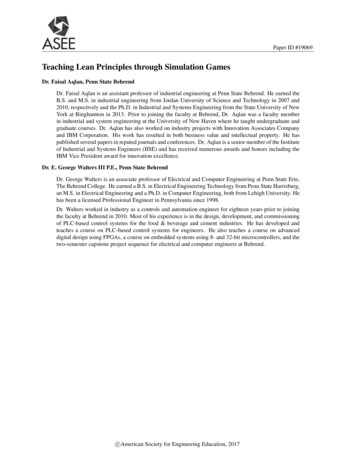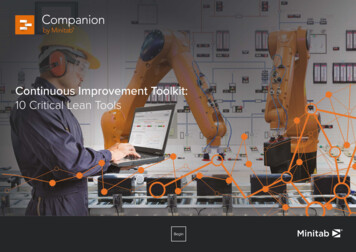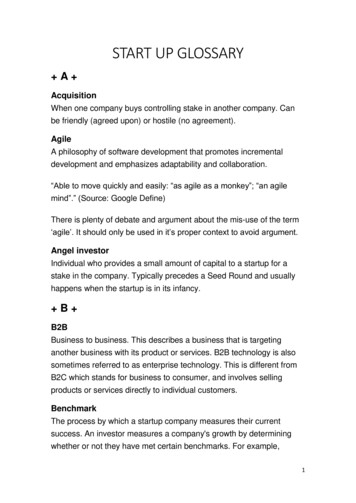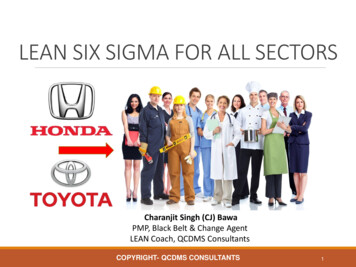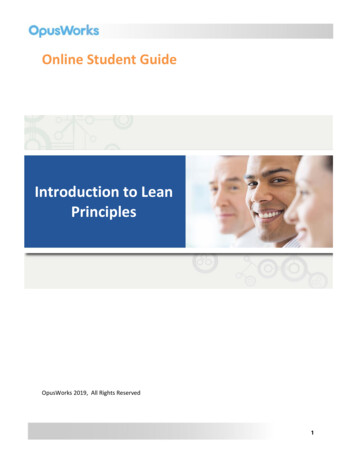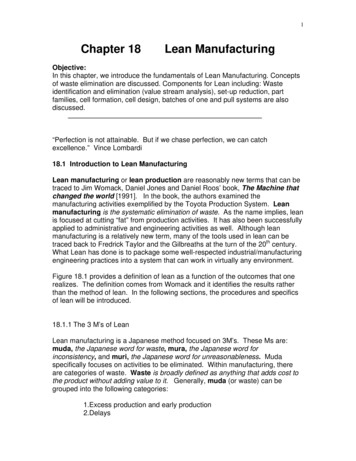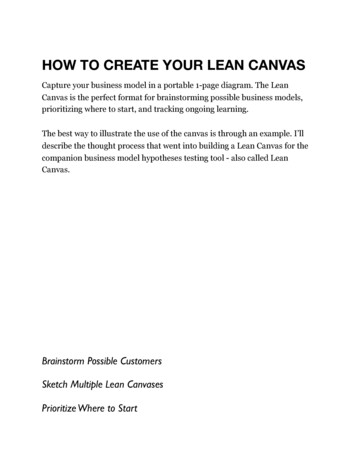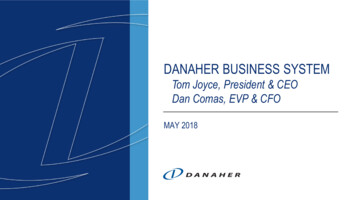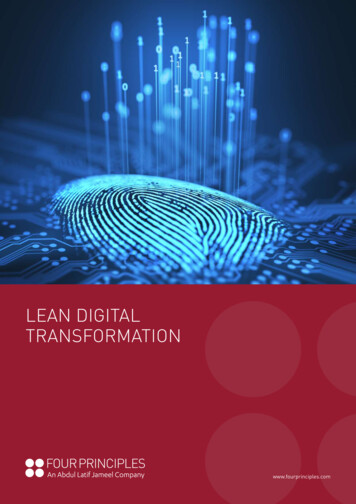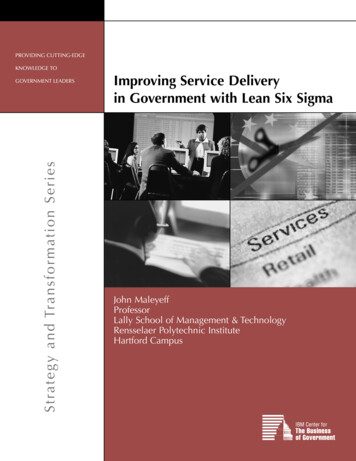
Transcription
providing cutting-edgeknowledge toS trate gy and Transformation Seriesgovernment leadersImproving Service Deliveryin Government with Lean Six SigmaJohn MaleyeffProfessorLally School of Management & TechnologyRensselaer Polytechnic InstituteHartford Campus
2007S tr at e g y a n d T r a n s f o rm ati o n s e ri e sImproving Service Deliveryin Government with Lean Six SigmaJohn MaleyeffProfessorLally School of Management & TechnologyRensselaer Polytechnic InstituteHartford Campus
T A B L EOFC ON T EN T SForeword.4Executive Summary.6Understanding Lean Six Sigma.8What Is Lean Six Sigma?.8Relationship to Performance Measurement.10Lean Six Sigma in the Public Sector.12Success Factors and Examples.12Using Lean Six Sigma for Improvements.15Unique Organizational Characteristics.16Unique Characteristics of Government Processes.17Starting a Lean Six Sigma Program.18Infrastructure Considerations.18Implementation Considerations.20Implementing a Lean Six Sigma Project.24Project Initiation.24Project Execution.26Project Communication.30The Future of Lean Six Sigma in Government.32Acknowledgments.34Appendix: Research Methodology.35Endnotes.36References.38About the Author.39Key Contact Information.40
Improving Service Delivery in Government with lean six sigmaF o r e w o r dOn behalf of the IBM Center for The Business of Government, we arepleased to present this report, “Improving Service Delivery in Government with Lean Six Sigma,” by John Maleyeff.Since the passage of the Government Performance and Results Act of1993, there has been increased interest in the federal government onimproving service delivery and delivering results. The 2007 ProgramAssessment Rating Tool scores for 977 agencies indicate that a keyimprovement area in the federal government is the execution anddelivery of results. Dr. Maleyeff’s report is a comprehensive review ofhow public sector managers can use Lean Six Sigma to improve theexecution and delivery of results.Albert MoralesThe hallmark of an effective report on a complex topic is that it is written in layman’s terms for practitioners at all levels, particularly thoseinterested in learning more about Lean Six Sigma. Dr. Maleyeff’s reportsets forth specific actions that public sector managers can take in starting and implementing Lean Six Sigma projects, and provides the readerwith a description of the Lean Six Sigma deployment process fromprogram development to project implementation.The report highlights the need to translate the Lean Six Sigma methodsfrom applications in manufacturing to the service-oriented environmentof the public sector. Specifically, Lean Six Sigma needs to take intoaccount the cross-functional flow of process and information, increasedtask variability, numerous handoffs, hidden benefits and costs, and thedifferent terminologies that are characteristic of the service environment.The report cites several examples of successful implementation and application of Lean Six Sigma projects in the public sector. It also enumerateskey success factors and potential pitfalls. In our research and past experience, we have found that the number one success criterion in deployingLean Six Sigma is the adamant commitment of senior leadership. IBM Center for The Business of GovernmentMonica Painter
Improving Service Delivery in Government with lean six sigmaAs we head further into the 21st century, we hope that processimprovement trends in government transformation, supported by theinnovative application of Lean Six Sigma as described in this report,will lead to more efficient and effective use of citizen tax dollars bypublic sector managers in providing services that meet or exceed theneeds of the public.Albert MoralesManaging PartnerIBM Center for The Business of Governmentalbert.morales@us.ibm.comMonica PainterAssociate PartnerIBM Global Business ernment.org
Improving Service Delivery in Government with lean six sigmaE x e cuti v eS umm a r yLean Six Sigma provides a means to improve thedelivery of services using a disciplined, project-basedapproach. It brings numerous advantages if implemented properly, but it also risks being regarded asanother management fad. In this report, guidelinesare recommended for the application of Lean SixSigma in government. They are targeted to administrators responsible for a wide range of public-sectorservices, including those provided to citizens andthose provided to internal customers.As methodologies, both Six Sigma and Lean haveevolved from collections of techniques to comprehensive management systems. Both strive to enhancecustomer service leading to sustained organizationalsuccess and both require a supporting organizationalculture. Their approaches differ somewhat, leadingsome to question their compatibility. But by understanding their fundamental principles, the combinedLean Six Sigma can be a powerful means to enhancecustomer satisfaction while managing costs.Managers of a service organization attempting toapply Lean Six Sigma often find their task complicated by two mitigating circumstances. First, muchof Lean Six Sigma terminology and many of its techniques were originally intended for manufacturing,and applying them to services has been challenging.Second, services by their nature possess special characteristics, for example, the importance of information and the abundance of cross-functional processflows. However, an increasing number of serviceorganizations have applied Lean Six Sigma to theirorganizations, including public sector organizations.Many of the potential barriers could exist in anyservice organization (public or private) but appear toexist in greater frequency in government, including IBM Center for The Business of GovernmentDefinition of Lean Six SigmaLean Six Sigma encompasses many commonfeatures of Lean and Six Sigma, such as an emphasis on customer satisfaction, a culture of continuousimprovement, the search for root causes, and comprehensive employee involvement. In each case, ahigh degree of training and education takes place,from upper management to the shop floor.inconsistent leadership motivation, union rules andregulations, job security concerns, and a prevalenceof undocumented processes. Other characteristicsunique to the public sector pose an additionalchallenge, including skepticism about government,legislative controls, competing special interests, theelection cycle, and term limits.Some governmental entities have managed to sustain a comprehensive improvement program overmany years. These organizations possess somecommonality, including: (1) they initiated andcontinue to preach a constancy of purpose basedon a consistent underlying methodology; (2) theirkey leadership positions have been in place forlengthy periods of time; (3) they guarantee thatemployees will not lose their jobs as a consequenceof an improvement project; and (4) they measuredtheir time to success in years rather than weeksor months.In this report, examples of successful processimprovement programs are highlighted at thelocal, state, and federal levels. A number ofimprovement projects illustrating the range ofLean Six Sigma’s influence are also described. TheLean Six Sigma guidelines are presented as two sets
Improving Service Delivery in Government with lean six sigmaof recommendations. At the program level, recommendations for creating a supporting infrastructureand organizational culture are presented along witha number of specific action items. At the individualproject level, guidelines for structuring a Lean SixSigma project are detailed.The creation of an infrastructure that supports theLean Six Sigma program requires that attentionbe given to four goals: (1) deploy a sound, consistent, and robust methodology; (2) build trust byremoving fear; (3) initiate long-term cultural change;and (4) communicate the vision to all stakeholders.Active commitment of leadership is a must, in bothwords and action.To further set the stage for a Lean Six Sigma program, it is recommended that: A centralized focal point be created who isdedicated to firmly establishing the programwithin the organization Departmental involvement be sought to create aworking relationship and enhance credibility Training be focused on a simple toolboxcontaining basic Lean Six Sigma skills Skilled facilitators, who are critical to projectsuccess, be obtained externally and/or developed internallyWithin a Lean Six Sigma program, specific projectswill be initiated. It is recommended that each LeanSix Sigma improvement project consist of threedistinct stages. During the project initiation stage,the guidelines recommend focusing on a structuredmechanism for project selection and project teamcreation. A disciplined project management structure is recommended for the project execution stagethat ensures focus on root causes of problems ratherthan their symptoms. The project communicationstage involves delivering project information earlyand often, using mechanisms that are accessibleto as many employees as possible.www.businessofgovernment.org
Improving Service Delivery in Government with lean six sigmaUnderstanding Lean Six SigmaIn their quest to grow and prosper, many businesses have combined two popular managementapproaches—Lean and Six Sigma—with the intention of building a more robust version of each.The result is typically referred to as Lean SixSigma. In this report, the application of Lean SixSigma in government is explored and guidelinesfor its implementation are recommended. Theseguidelines will consist of a disciplined, projectbased approach that ensures effectiveness ofimprovement efforts. They will be useful to administrators responsible for a wide range of publicsector organizations that range in size fromfederal to local, and in function from revenuemanagement to homeland security.Instituting a formal process improvement programcan provide great benefits. It can serve to consistently reinforce the notion that administrators havetwo important jobs—managing and improving. WithLean Six Sigma, improvement projects follow a prescribed mandate and structure, guaranteeing thatimportant problems are attacked using a sound andconsistent methodology. It can avoid pitfalls common to efforts that address symptoms, rather thancauses, of problems and enforce the use of data indecision making.The consistency of approach provided by Lean SixSigma enhances the effectiveness of project teamsand allows for the sharing of project results acrossthe organization. Disciplined follow-up ensures thatproject team recommendations are implementedand tracked. But sustaining Lean Six Sigma requiresa culture that actively supports process improvementin both words and actions. And the active commitment of leadership is a must. IBM Center for The Business of GovernmentWhat Is Lean Six Sigma?Both Lean and Six Sigma have come to be considered management approaches rather than a collection of techniques. Some practitioners consider Leanand Six Sigma to be mutually exclusive while otherssee more similarities than differences. Either way, itis useful for practitioners to understand the originsof each approach and their philosophical roots.Lean1Lean can be defined as a management approachthat seeks to maximize value to customers, bothinternal and external, while simultaneously removing wasteful activities and practices. It is based onthe management system used at Toyota MotorCorporation, with Shigeo Shingo and TaiichiOhno generally considered to be its architects.Womack, Jones, and Roos,2 in a worldwide studyof automobile manufacturing, used the term “lean”to describe the activities that seek to minimizewaste, such as excess inventory and defectiveproducts.3 Their study concluded that Lean waspreferable to “mass production” prominent in theUnited States and Europe. Lean manufacturinggradually found its way in the mainstream jargonduring the mid to late 1990s.Definition of Lean Six SigmaLean Six Sigma encompasses many commonfeatures of Lean and Six Sigma, such as an emphasis on customer satisfaction, a culture of continuousimprovement, the search for root causes, and comprehensive employee involvement. In each case, ahigh degree of training and education takes place,from upper management to the shop floor.
Improving Service Delivery in Government with lean six sigmaFigure 1: Lean Six Sigma Builds on Practical Lessons Learned from Previous Eras of Operational ImprovementJust in Time (1980s)(Kanbans, Pull systems,Visual m)Total Quality Management (1980s)(Statistical Process Control, Qualitycircles, Kaizen, Culture change/benchmarking, Baldrige, ISO9000)Business Process Reengineering(1990s)(Downsizing, “To be” processes,Process owners)Motorola – Six Sigma(1980s)GE (1980s-1990s)Intensity of changeSix Sigma (Applied method for growth and productivity)Change Acceleration Process (CAP) (Change method and tools)Lean Six Sigma lity)Lean Production (1990s)(“Machine that changed the world,”“Lean Thinking,” Value stream mapping)Customer Partnering (GE Toolkit, Customer CAP)Process Improvement (New Product Introduction, Supply chain, Suppliers)Best Practices (Benchmarking, Across and outside of GE, Ending NotInvented Here)Work-out (Kaizen type, Cross functional teams, Boundarylessness, Values)Strategy (Number 1 and Number 2 in each business, Fix, close or sell)Source: IBM Institute for Business Value, Driving Operational Innovation Using Lean Six Sigma.Lean Thinking4 introduced many practitioners to Lean,including a five-step application guide: (1) specifyvalue from the customer’s perspective; (2) identifythe stream of processes used to provide value;(3) remove non-value-added activities from the valuestream; (4) create pull by having all work initiated bycustomer demand; and (5) strive for perfection.The application of Lean principles in healthcare,services, and internal business processes is nowunder way. But since Lean was originally motivatedby competitive pressures in manufacturing, muchof its jargon and many of its techniques apply tomanufacturing operations, and special efforts mustbe undertaken to successfully apply Lean to services. For example, the relevance of the five-stepguide may not be apparent when applied to a service or business process since inventory as suchgenerally would not exist. However, many of thedescriptive and intuitive tools of Lean apply nicelyto services, and its overall goals do not conflict withthose of a service manager.Successfully applying Lean requires a long-termviewpoint that considers all stakeholders. That is,Lean will only succeed if the organization’s infrastructure reflects a common focus, which is oftendifficult to achieve in a large bureaucracy. Forexample, Emiliani5 details how a manufacturerachieved significant profitability and growth, emphasizing that the marketing, accounting, design, andsales departments needed to modify their operationsto support Lean. Lean, therefore, cannot achievesustained success unless executives, as well as middle managers and their staff, are active participants.Six Sigma6Six Sigma can be defined as a management approachthat seeks to maximize profits by systematicallyapplying scientific principles to reduce variation andthus eliminate defects in product and service offerings.In 1986, the foundations of Six Sigma were established by Bill Smith at Motorola Corporation inresponse to product quality challenges. The application of Six Sigma contributed to Motorola winningthe Malcolm Baldrige National Quality Award(MBNQA7) in 1988.The statistical roots of the term six sigma8 havebecome less important as Six Sigma has evolved intoa comprehensive management system. Many practitioners, however, continue to view Six Sigma as a set oftechniques that promote variance reduction. The popularity of Six Sigma was boosted dramatically when itwas adopted by GE Corporation under the leadershipwww.businessofgovernment.org
Improving Service Delivery in Government with lean six sigmaKey DefinitionsKaizen (pronounced k ı̄ -zen) literally means “change for the better.” It is typically used to denote a short term(one-to-five-day) focused process improvement effort during which a multi-stakeholder project team worksfull-time on the project, often led by a professional facilitator known as a “sensei.”DMAIC is an acronym for “Define, Measure, Analyze, Improve and Control” and refers to a systematic five-stepapproach to running a process improvement project; its origins would be found in early quality programs suchas the Plan-Do-Study-Act structure developed by Walter Shewhart in the 1930s.of Jack Welch. While Six Sigma is most easily understood in a manufacturing context, it can and has beenapplied to healthcare and other services. But it is notclear that all of the Six Sigma tools, particularly thestatistically based methods, are necessary in servicesor that professional service employees would be ableto apply them as well as their more technically sophisticated counterparts in manufacturing.But it is equally clear that differences exist. Leanmanagers tend to be somewhat holistic, satisfiedwith removing wasteful activities that hinder theirability to serve customers. Six Sigma managers tendto be financially driven, focusing directly on costsavings or revenue increases as the criteria for success.The similarities and differences of Lean and Six Sigmaare listed in Table 1.Six Sigma projects are formalized and highly structured, making use of scientific approaches in theselection and management of projects. Six Sigmaprojects use a DMAIC structure, considered bymany practitioners to be the primary reason for SixSigma’s success. DMAIC enforces a high degree ofdiscipline and commonality in project organization,problem-solving tools, software, and terminology.It is easy to envision several varieties of Lean SixSigma. A version offered here would be characterized as follows. The Lean influence would causethe organization to: (1) maintain an understandingof both internal and external customers’ needsand desires; (2) seek to maximize the value-addedcontent of all processes; (3) constantly evaluateemployee incentives to ensure their alignment withsystemwide performance objectives; and (4) lookbeyond strictly financially quantifiable cost savings.The Six Sigma influence would cause the organization to: (1) stress data-driven decisions that arebased on facts rather than opinions; (2) devoteresources to solving problems that present significant challenges to business success; and (3) implement a consistent, highly structured project-basedimprovement regimen.Six Sigma implementation would begin with executive education followed by extensive training throughout the organization. Typically, formalized levels oftraining would be established, with project and mentoring roles often defined by a “belt” level (for example, master black belt, black belt, green belt, and soon). The tools of Six Sigma include well-knownproblem-solving techniques and popular statisticalapproaches, and a common software platform wouldusually be integrated to achieve a consistent meansof internal communication. Six Sigma black beltcertification is becoming a standard by which manyquality practitioners are judged.Lean Six SigmaDespite their disparate roots, it is clear that Lean andSix Sigma encompass many common features, suchas an emphasis on customer satisfaction, a culture ofcontinuous improvement, the search for root causes,and comprehensive employee involvement. In eachcase, a high degree of training and education takesplace, from upper management to the shop floor.10IBM Center for The Business of GovernmentRelationship to PerformanceMeasurementConfusion often exists concerning how processimprovement relates to performance measurement,which many governmental entities have embracedas an important component of their managementsystem. Performance measurement can and possiblyshould play a key role in an effective processimprovement program. But process improvementsare not a natural consequence of effective performance measurement. That is, a process improvement mentality will not take root without additional
Improving Service Delivery in Government with lean six sigmaTable 1: Comparison of Lean and Six SigmaFocal PointLeanSix SigmaSimilar TendenciesMain goalOrganizational survival and/or growth through superior and improving customer satisfaction.ExecutiveinfluenceMust be committed and actively involved in the program’s implementation and operation.Tools andtechniquesInclude basic root cause analysis, problem solving, process analysis, and data analysistechniques.EmployeeEmployees are trained and encouraged to contribute to problem solving and to identifyinvolvement problems as they occur.ApplicationareasInitially focused on manufacturing but can and has been applied to other industries,including service, healthcare, and education.Potential DifferencesProjectTend to be expeditious Kaizen projectsmanagement completed in a few days with the teamworking full-time on the effort.Tend to be deliberate projects consumingmultiple months using a disciplined structure.ProjectfocusTend to focus on improving customer serviceby minimizing wasteful practices.ProjectselectionTend to be based on removing significantTend to be based on a quantitative analysiswaste and/or adding more value for custom- of cost savings and/or revenue enhancements.ers, with multiple criteria used as justification.AnalysistechniquesTend (traditionally) to be geared toward descrip- Tend (traditionally) to be geared toward statistitive displays (e.g., process maps), root causecal data analysis, controlled experimentation,analysis, and mistake proofing.and optimization.commitment and resources. In fact, performancemeasurement systems can pose a barrier unlessadministrators are cognizant of the following: Recognizing the value of performancemeasurement data in process improvementMost performance data are designed to evaluateeffectiveness by focusing on metrics that represent how well and how efficiently services areprovided. While these “outcome” data can bevaluable in highlighting areas of concern, theirrole is often less valuable during improvementprojects that require “process” data. An importantreason for this disconnect is that most serviceprocesses flow across departments and it is difficult to attribute overall performance to any singledepartment. For example, a finance departmentmay experience complaints about the accuracyof bills, but the root cause of the inaccuraciescould be found in another department that provides the finance department with billing-relatedinformation. An added data collection effortwould be required to determine the root causeof the department’s billing inaccuracies. Tend to focus on improving customer serviceby minimizing variation and reducing errors.Understanding variation is crucialContemporary quality management offers a“process oriented” viewpoint, where the goalof data is to create a fundamental understandingof the process that generated the data. This goalcannot be achieved unless the existence of variation is understood. For example, the number ofphone calls received by a municipality will varyfrom month to month, even if all of the serviceprocesses remained unchanged. An appropriatephrase would be “the data changed but theprocess remained the same.”Administrators who do not appreciate variationwill often react to changes in the data evenwhen no important process changes haveoccurred. These reactions waste time and resultin frequent priority adjustments as new dataarrive followed by the inevitable over-reaction.Employees grow frustrated and frequently resortto the well-known practice of gaming performance data.www.businessofgovernment.org11
Improving Service Delivery in Government with lean six sigmaLean Six Sigma in the Public SectorToday, many public sector managers are well awareof quality and process improvement methodologies.The government division of the American Societyfor Quality, for example, includes about 1,000members in the United States and Canada.9Many such managers across the nation are nowapplying various process improvement methodologies within the public sector. Most have met withmixed success, in many cases applying provenmethods periodically but not systematically. Readersinterested in the research methodology, includinghow many of these individuals participated in theeffort, should refer to the Appendix of this report.Success Factors and ExamplesOrganizations that have maintained a long-standingand comprehensive process improvement programsuch as Lean Six Sigma possess many common features. It is clear that these features enhance theirability to sustain the efforts over a period of time.12 They have been inspired by influences emanating outside of the public sector, usually a leaderwith business experience. They have experienced little leadership turnover. They paved the way for the program’s implementation by removing organizational barriersand modifying its culture. They focus on certain underlying principlesand maintain a consistent conceptual framework, based on Lean and/or Six Sigma, or alternatively Total Quality Management (TQM),10 theMBNQA guidelines, or the family of standardsset by the International Organization forStandardization (ISO).11IBM Center for The Business of Government They began by employing a full-time administrator to oversee the program’s implementation, butthis position was often considered temporaryuntil the program was up and running so as notto create an unnecessary bureaucracy. However,a champion for the effort will continue to beneeded in the organization. They offer a guarantee to employees that nolayoffs will result from a process improvement project. They make conscious efforts to communicateprogram successes internally, such as postingproject results electronically or placing storyboards in prominent locations. They face similar challenges, revealed byresponses to a question asking respondents toconsider a list of 20 potential organizational barriers, where most respondents chose the majorityof the list as at least somewhat troublesome. They did not achieve success overnight, withmost taking several years to create a culture thatcharacterizes and sustains their program.City of Fort WayneSince his election in 2000, Mayor Graham Richardof Fort Wayne, Indiana, has led a Lean Six Sigmaeffort. The result is savings estimated to be about 11 million, with no tax increases and increasesin citizen satisfaction. The mayor attributes his16-percentage-point re-election in 2004 to enhancedcustomer service. While working in the private sector,Richard founded the TQM Network and had firsthandexperience with Six Sigma. He brought an entrepreneurial spirit to the city and has devoted considerable energy to the Lean Six Sigma efforts.
Improving Service Delivery in Government with lean six sigmaLean Six Sigma in the Department of DefenseIn the public sector, the Department of Defense (DoD) has been a leader in the implementation of Lean SixSigma. The summary below offers an overview of activities now in DoD.In the Office of the Secretary of DefenseIn April 2007, the Office of the Secretary of Defense publicly articulated the need to institute a framework to support the acceleration of transformation throughout the department. The initiative was called Continuous ProcessImprovement and Lean Six Sigma (CPI/LSS). Supporters of the transformation initiative include DoD senior leaders who have experience within the private sector and who have seen firsthand the success experienced with theuse of continuous process improvement and Lean Six Sigma.The CPI/LSS initiative includes the CPI/LSS Senior Steering Committee, which will guide the development of anew CPI/LSS Program Management Office. The new Program Management Office (PMO) will lead DoD-wideCPI/LSS activities by tracking progress and results, as well as formulating an incentives program to encouragefurther use of CPI/LSS methods throughout DoD. The PMO is also planning to issue DoD-wide CPI/LSS goals,including using CPI/LSS in individual performance objectives.Currently, efforts are under way to complete an initial set of CPI/LSS projects and refine priorities that establishan increased number of targets of opportunity within DoD.In the United States ArmyThe challenge for the United States Army now is to broaden the
ing and implementing Lean Six Sigma projects, and provides the reader with a description of the Lean Six Sigma deployment process from program development to project implementation. The report highlights the need to translate the Lean Six Sigma methods from applications in manufacturing
